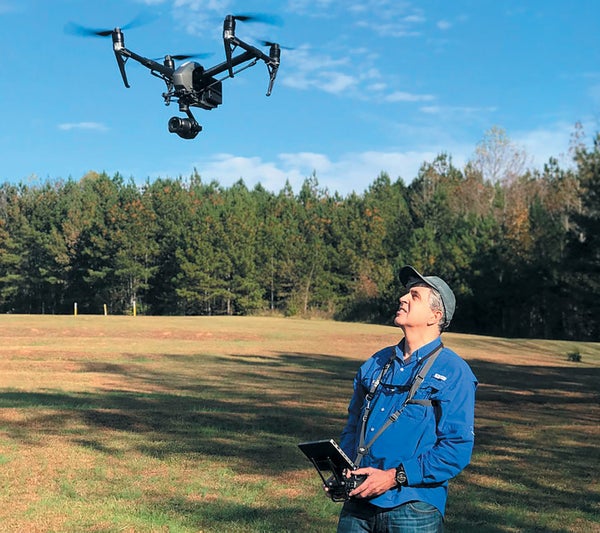Peter Essick
March of the Mangroves
In his career as a nature photographer, Peter Essick (above) has traveled to all 50 U.S. states, more than 100 countries and each of the seven continents. But while taking pictures for this issue’s feature story on mangroves’ migration into new habitats, by journalist Michael Adno, he remained closer to home. Essick, who lives near Atlanta, Ga., went to Florida’s Atlantic coast to accompany three experts as they pieced together the mystery of the northward-marching mangroves. “It’s like a little detective story,” he says. To capture the beauty of these swampy ecosystems, he donned rubber waders and wetsuits and piloted a drone.
Essick worked with National Geographic for 30 years, documenting both pristine natural beauty and ecosystems profoundly disrupted by humans. In his recently published photo book, Work in Progress (Fall Line Press), Essick documents the construction and urban development that are spreading out from Atlanta and threatening local ecosystems. “There’s nothing stopping it here in Atlanta in terms of a river or a mountain range,” he says; it’s going to “keep sprawling.”
On supporting science journalism
If you're enjoying this article, consider supporting our award-winning journalism by subscribing. By purchasing a subscription you are helping to ensure the future of impactful stories about the discoveries and ideas shaping our world today.
Kate Wong
What Did Humans Evolve to Eat?
If you look for a diet to follow, you’ll encounter many scientific-sounding claims. A common one is that a particular diet is “what humans evolved to eat,” says Kate Wong, a senior editor at Scientific American, who has been covering archaeology and evolution for the magazine for more than two decades. “I wanted to ‘gut check’ that, if you will, against the fossil and archaeological record,” says Wong, whose feature in this issue’s special report takes on the question of what foods humans actually evolved to consume. “I’m not going to be telling you what to eat in this article. But what I can say is that humans evolved to be flexible eaters.”
Wong’s fascination with evolution and human origins goes way back. As a child, she went on a school trip to the American Museum of Natural History in New York City “and kind of fell in love with the place.” After studying biological anthropology in college, she briefly worked at the museum as a docent before getting a job at Scientific American, and the rest is history. She loves thinking about bygone worlds through fossils and artifacts. “I like looking at them and thinking about deep time and wondering what life was like back then,” Wong says. “This is all like catnip to me.”
Lauren J. Young
Turning Down the Food Noise
For the past couple of years Ozempic and similar drugs with weight-loss effects have been in the news constantly—and Lauren J. Young has been following the twists in the science as they occur. “So much of this research is happening basically in real time,” says Young, associate editor for health and medicine at Scientific American. Drugs like Ozempic mimic a hormone called glucagonlike peptide 1 (GLP-1) and have actions that go far beyond weight loss. “This hormone seems to affect so many aspects of the body”—including how our brains process hunger and cravings. For the special report in this month’s issue, Young set out to learn why.
Young grew up near Fresno, Calif., as the child of a pediatric dietitian and a food microbiologist. “Some of my best stories have come out of conversations with [my parents],” she says. Those include a project on Valley Fever, an understudied but potentially serious infection caused by a soil-dwelling fungus common in the U.S. Southwest. “The sheer number of people that story seems to have touched” is remarkable, Young says. “One of the most rewarding things about health journalism is that you really have direct impact for patients.”
Ni-ka Ford
The Great Weight Debate
Ni-ka Ford has always known that she wanted to be an artist. But she wasn’t sure how to channel that passion until her final year as a studio art major in college. She remembers one day in an art studio when she was looking out the window at a tree. “And I was like, ‘Wow, the branches really look like veins in the body,’” she says. This inspiration led her to notice “a lot of similarities between our bodies and nature” and drew her to the field of medical illustration. Today her work distills medical complexity into illustrations and graphics that appear in journal articles, teaching materials and popular publications. For this issue’s special report, Ford depicted both healthy and unhealthy adipose tissue in a feature on being heavy and healthy by journalist Christie Aschwanden.
Ford takes care to feature a range of body types and skin tones in her work. “I’m really passionate about bringing more diversity and representation into medical illustrations,” which often feature exclusively white and slim bodies, she says. And as she creates her illustrations, she continues to take inspiration from nature, often picking her color palettes from photographs she has taken of sunsets. “What I found is that in nature, colors always look good together,” Ford says. “I have made [this method] kind of a signature in my work.”
